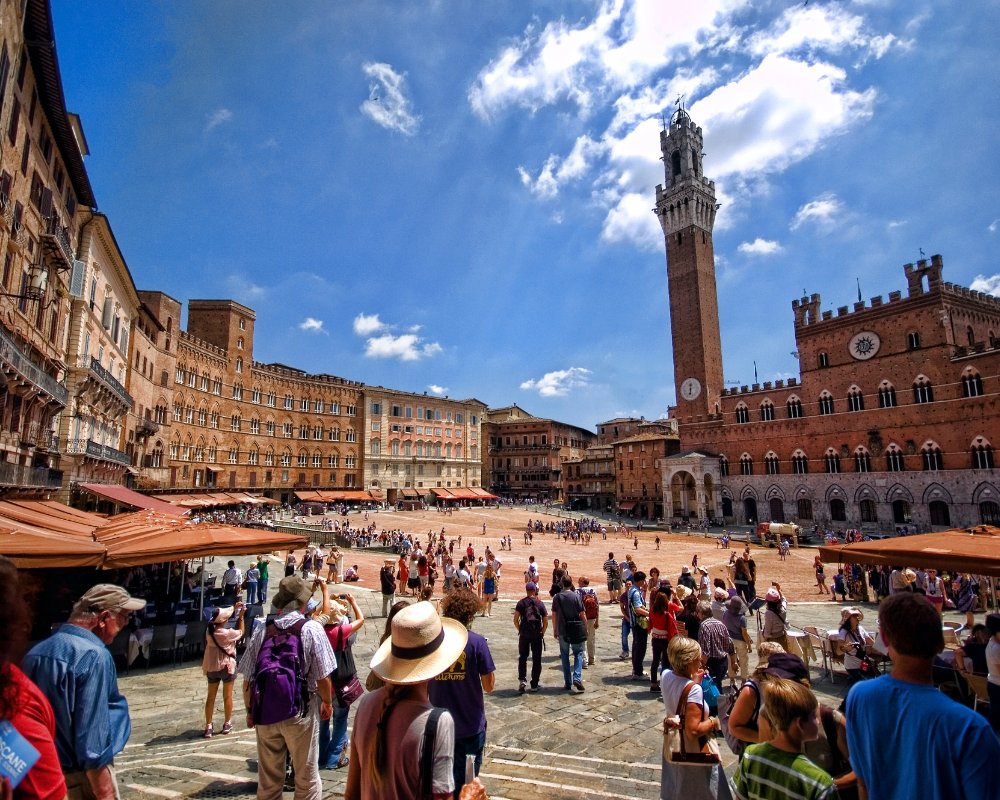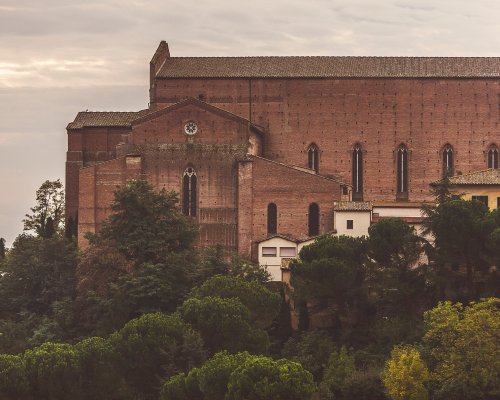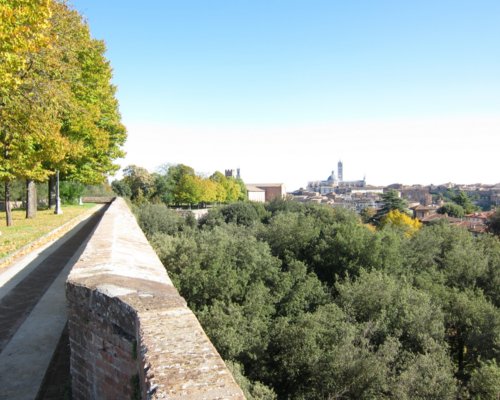A journey that touches unusual locations in the Palio city
An itinerary to discover the most incredible views in the city. A journey that touches fountains, towers, castles and artisan workshops.
Fontebranda, originally artisan settlements and subsequently public slaughterhouses, has now cleverly been restored to host the first artisan citadel. Master goldsmiths, glass makers, ceramists, printers (and more) work with the ancient techniques of the Sienese. Climb the staircase below the tufa cliff that supports the Basilica of San Domenico. We continue up to a "terrace" from which we can enjoy a sweeping view: on the left, the imposing convent and the Basilica of San Domenico, while in the background, the Duomo.
Fontebranda, originally artisan settlements and subsequently public slaughterhouses, has now cleverly been restored to host the first artisan citadel. Master goldsmiths, glass makers, ceramists, printers (and more) work with the ancient techniques of the Sienese. Climb the staircase below the tufa cliff that supports the Basilica of San Domenico. We continue up to a "terrace" from which we can enjoy a sweeping view: on the left, the imposing convent and the Basilica of San Domenico, while in the background, the Duomo.
From the top of the ramparts of the imposing 16th-century fortress, you can enjoy a beautiful view of the medieval city and the fields that surround it. The Medici Fortress has for years been the seat of the National Jazz Academy, which hosts international musicians each year.
From the top of the ramparts of the imposing 16th-century fortress, you can enjoy a beautiful view of the medieval city and the fields that surround it. The Medici Fortress has for years been the seat of the National Jazz Academy, which hosts international musicians each year.
It is the first urban section of the ancient Via Francigena. The pilgrims passing through Siena, tired from the journey, could rest at the Magione, while the church of S. Pietro alla Magione offered their spirits comfort. At the beginning of Via Campansi, you can enjoy a sweeping view of the Chianti hills, lined with villas and farms, and the profile of the Basilica of the Observance.
It is the first urban section of the ancient Via Francigena. The pilgrims passing through Siena, tired from the journey, could rest at the Magione, while the church of S. Pietro alla Magione offered their spirits comfort. At the beginning of Via Campansi, you can enjoy a sweeping view of the Chianti hills, lined with villas and farms, and the profile of the Basilica of the Observance.
We continue on Via del Pignattello. In the Middle Ages, this road was populated by potters who produced pots, small ceramic or terracotta bowls which, when filled with oil and a wick, were used to light homes. We turn left onto Via degli Umiliati to reach the gates of Villa Rubini. Following the path, we come to a terrace overlooking the city: from the Basilica of San Francesco, our gaze moves towards the bulk of the dome of Provenzano. Behind the Rocca Salimbeni, the Torre del Mangia peaks out, while on the right, the façade of the Duomo emerges. From Via dei Montanini, we go down the steep slope of Vallerozzi towards Pian d’Ovile. Then take Via del Lavatoio to the left.
We continue on Via del Pignattello. In the Middle Ages, this road was populated by potters who produced pots, small ceramic or terracotta bowls which, when filled with oil and a wick, were used to light homes. We turn left onto Via degli Umiliati to reach the gates of Villa Rubini. Following the path, we come to a terrace overlooking the city: from the Basilica of San Francesco, our gaze moves towards the bulk of the dome of Provenzano. Behind the Rocca Salimbeni, the Torre del Mangia peaks out, while on the right, the façade of the Duomo emerges. From Via dei Montanini, we go down the steep slope of Vallerozzi towards Pian d’Ovile. Then take Via del Lavatoio to the left.
We pass in front of the apse of the church of San Rocco Confessore (end of the 15th century) where we can see the baptismal font from the Contrada della Lupa. Continuing along Via Vallerozzi, we arrive at Porta Ovile (13th century) to take the steep Via del Comune, one of the most picturesque streets in Siena with the houses learning one against the other like a staircase. Once we reach Piazza S. Francesco, we can see a Franciscan church, inside which the Sacred Particles have been kept intact for almost three centuries. The Oratory of San Bernardino also overlooks the square and houses the Diocesan Museum of Sacred Art.
We pass in front of the apse of the church of San Rocco Confessore (end of the 15th century) where we can see the baptismal font from the Contrada della Lupa. Continuing along Via Vallerozzi, we arrive at Porta Ovile (13th century) to take the steep Via del Comune, one of the most picturesque streets in Siena with the houses learning one against the other like a staircase. Once we reach Piazza S. Francesco, we can see a Franciscan church, inside which the Sacred Particles have been kept intact for almost three centuries. The Oratory of San Bernardino also overlooks the square and houses the Diocesan Museum of Sacred Art.
We descend into the Vicolo del Fontino until we reach the Basilica of Santa Maria in Provenzano. The church was solemnly consecrated on 23 October 1611, with the addition of the Virgin’s terracotta on the high altar. The Palio on July 2 is held in honor of the Madonna of Provenzano.
We descend into the Vicolo del Fontino until we reach the Basilica of Santa Maria in Provenzano. The church was solemnly consecrated on 23 October 1611, with the addition of the Virgin’s terracotta on the high altar. The Palio on July 2 is held in honor of the Madonna of Provenzano.
We enter a lovely triangular square, between the Vicoli della Torre and the Coltellinaio, dominated by the elegant Palazzo Tolomei. In front of the noble Palace is the Church of San Cristoforo (11th century). We arrive in the square locally known by the Sienese as "Piazza del Monte".
We enter a lovely triangular square, between the Vicoli della Torre and the Coltellinaio, dominated by the elegant Palazzo Tolomei. In front of the noble Palace is the Church of San Cristoforo (11th century). We arrive in the square locally known by the Sienese as "Piazza del Monte".
We continue towards Via delle Terme, where in Roman times, there were spas, to reach Via di Città. Arriving at the steep Costarella dei Barbieri, we come to one of the most spectacular views of the city: Piazza del Campo framed by Palazzo Pubblico. Once we’ve reached the Baptistery of San Giovanni Battista, we can go to the Vicolo delle Carrozze and from here, we arrive in Via di Diacceto where we can enjoy a breathtaking view of Fontebranda dominated by the Basilica of San Domenico. Continuing onwards, we return to Fontebranda.
We continue towards Via delle Terme, where in Roman times, there were spas, to reach Via di Città. Arriving at the steep Costarella dei Barbieri, we come to one of the most spectacular views of the city: Piazza del Campo framed by Palazzo Pubblico. Once we’ve reached the Baptistery of San Giovanni Battista, we can go to the Vicolo delle Carrozze and from here, we arrive in Via di Diacceto where we can enjoy a breathtaking view of Fontebranda dominated by the Basilica of San Domenico. Continuing onwards, we return to Fontebranda.


